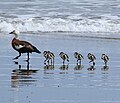Paradise Shelduck
| Paradise Shelduck | |
|---|---|
 | |
| Male, left, female, right, at Karori Wildlife Sanctuary | |
| Conservation status | |
| Scientific classification | |
| Kingdom: | Animalia |
| Phylum: | Chordata |
| Class: | Aves |
| Order: | Anseriformes |
| Family: | Anatidae |
| Subfamily: | Tadorninae |
| Genus: | Tadorna |
| Species: | T. variegata |
| Binomial name | |
| Tadorna variegata (Gmelin, 1789) | |
The Paradise Shelduck (Tadorna variegata) is a large goose-like duck endemic to New Zealand. They are known to the Māori as Pūtangitangi but now commonly referred to as the "Paradise duck", and are prized game birds. Both the male and female have striking plumage, the male has a black head and barred black body, the female a white head with a chestnut body.
The Paradise Shelducks usually live as pairs, grazing on grass and weeds, and will raid crops, particularly when molting.
Breeding
Paradise Shelducks form long-term pair bonds, often lasting for life, and defend territories. They have a long breeding season, lasting from August through December.They reach sexual maturity after two years, and build nests lined with grass and feathers hidden in high grass, inside hollow trees, or beneath rotting logs. The mean clutch size is around nine eggs. Chicks fledge after eight weeks.
History
Before Europeans settled in New Zealand the Maori hunted Paradise Shelducks in favoured districts. Hunting was done outside the breeding season when the birds were molting and could not fly. During the breeding season hunting them was forbidden. This conservation and selective hunting system ensured good supplies of food.
Paradise Shelducks were uncommon prior to European settlement, however changes to habitat caused by the conversion of forest to pasture, and the deliberate provisioning on ponds by hunting groups, has led to a large increase in the numbers of these ducks.
The name
The genus name Tadorna comes from Celtic roots and means "pied waterfowl", essentially the same as the English "shelduck".





No comments:
Post a Comment